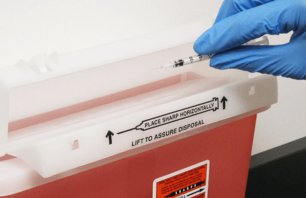The National Oceanic and Atmospheric Administration (NOAA) National Weather Service forecasters predicted the 2024 Atlantic hurricane season to be more volatile than usual with an expected 17 to 25 total named storms between May and November. As of mid-October, 2024, there have been 13 named storms, including four tropical storms and nine hurricanes. Of those hurricanes, four have been major, and it’s not over yet.
With climate change making extreme weather less predictable and more intense, it’s important for organizations to plan for emergencies, and waste management should be a part of that plan. Healthcare administrators should review their organization’s resources and reporting systems to effectively prepare for emergencies. These range from man-made disasters to severe weather to virus outbreaks. Early problem solving can help alleviate stress among healthcare professionals and ensure the organization is ready to respond.
Healthcare providers work tirelessly every day to protect the well-being of their patients, but an unsafe and inefficient work environment could result in unnecessary stress on healthcare staff. Creating a safe healthcare workplace is important to support the people who care for others. Since hospitals and health systems must remain operational regardless of the disaster, plans should be put in place to address their continuing care, including waste management needs.
Occupational Safety and Health Administration: Emergency Preparedness and Response
The Occupational Safety and Health Administration (OSHA) requires most organizations to have an Emergency Action Plan to facilitate and organize employer and employee actions during workplace emergencies. OSHA defines a workplace emergency as any event that “threatens workers, customers, or the public, disrupts or shuts down operations or causes physical or environmental damage.”
Fostering a trusting relationship with your employees and confirming you understand applicable regulations before a crisis can help save time and avoid panic when an incident occurs. Stericycle’s Steri-SafeTM program offers customers emergency preparedness plan templates and a safety plan builder, a step-by-step guide to creating your plans.
Emergency Preparedness, Planning, and Response: HIPAA
After the Ebola outbreak, the U.S. Department of Health and Human Services (HHS), Office for Civil Rights, issued a bulletin for HIPAA covered entities and their business associates to ensure they know the ways in which protected health information (PHI) can be shared under the HIPAA Privacy Rule during an emergency and to remind them that the Privacy Rule protections still apply during an emergency.
HHS provides guidance on the release of PHI for planning or response activities during an emergency. HHS has a tool designed to help emergency preparedness and recovery planners in determining how to get access to and use PHI consistent with the Privacy Rule.
HIPAA also has rules on contingency planning for each type of foreseeable disaster that includes data backup, emergency mode operations, and disaster recovery. Plans should cover all types of emergencies, including natural disasters, fires, vandalism, system failures, cyberattacks, and ransomware incidents.
HIPAA Rules on contingency planning can be found in the Security Rule administrative safeguards -45 CFR § 164.308(a)(7)(ii)(A-E).
- Develop and Implement a Data Backup Plan – 308(a)(7)(ii)(A)
- Develop a Disaster Recovery Plan – 308(a)(7)(ii)(B)
- Develop an Emergency Mode Operation Plan – 308(a)(7)(ii)(C)
- Develop and Implement Procedures for Testing and Revision of Contingency Plans – 308(a)(7)(ii)(D)
- Perform an Application and Data Criticality Analysis – 308(a)(7)(ii)(E)
Stericycle’s Steri-Safe HIPAA program has templates, which can assist you in creating policies for operating during an emergency.
Partner with Trusted and Reliable Vendors
Compliance management should be considered as part of your emergency preparedness plan. One way to help prepare for an emergency is to consult a trusted and reliable partner that has the ability to handle your regulated medical waste even in an emergency. Working with a service provider, such as Stericycle, which has a nationwide footprint, an extensive truck fleet, responsive team members, and open customer communication can help healthcare organizations with their waste management needs during uncertain times.
How Stericycle Prepares for Emergencies
We actively monitor inclement weather and watch for alerts from state agencies and local governments. Managers from our potentially impacted facilities collaborate with our Environmental Health and Safety team to closely monitor a storm’s progress. Since weather emergencies, such as hurricanes, snow storms, and thunderstorms, can change course and severity literally overnight, it is critical that we have eyes on what’s occurring and be ready to adapt our response accordingly.
Depending on the emergency and predicted effects, the Environmental Health and Safety team will decide whether or not to activate our emergency management plans. These are detailed blueprints that describe how we prepare for, respond to, and recover from a range of emergencies, including hurricanes. More specifically, the plans outline how we should secure our buildings and their contents; maintain our clients’ business continuity; and safeguard team members, whether they are working in our facilities or at home.
How Stericycle Can Help Healthcare Facilities During Emergencies
Due to the volatile nature of emergencies, it is critical for our team to be prepared for anything. Those on the front lines are always thinking creatively about how to serve customers that can’t pause their operations. Our response is always evolving because every situation is different. We learn from each event and continue to refine our emergency preparedness program to ensure we provide the safest, most responsive service amid challenging dynamics.
Learn more about how Stericycle can serve as a key partner to healthcare organizations during emergencies.



